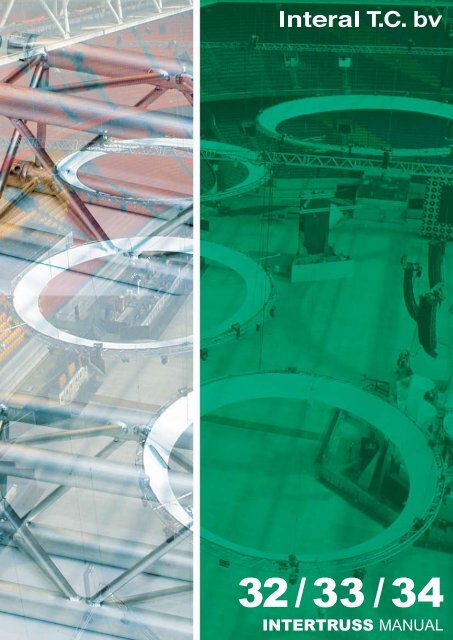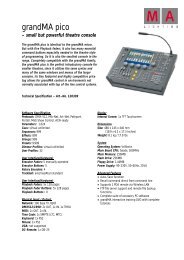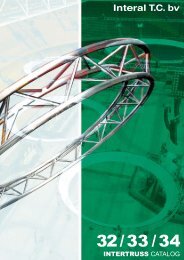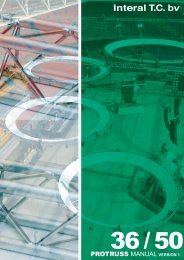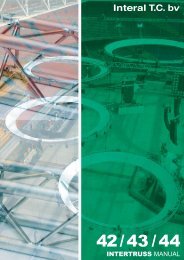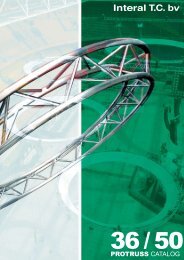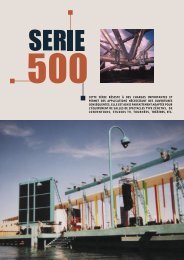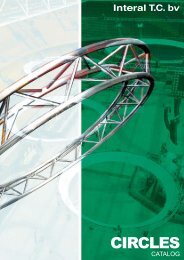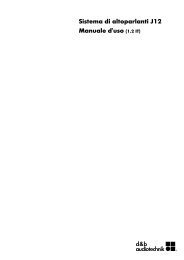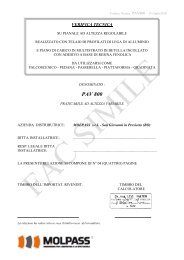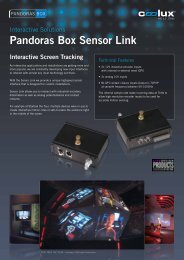INTERTRUSS MANUAL
INTERTRUSS MANUAL
INTERTRUSS MANUAL
Create successful ePaper yourself
Turn your PDF publications into a flip-book with our unique Google optimized e-Paper software.
32 / 33 / 34<br />
<strong>INTERTRUSS</strong> <strong>MANUAL</strong>
INFORMATION<br />
technical specifications Intertruss<br />
Type<br />
32 = Flat<br />
33 = Triangle<br />
34 = Square<br />
Alloy 51 st. AlMgSi 1 F 31<br />
ISO Standard AlMgSi EN-AW 6082 T6<br />
Connection<br />
FS Alu. connection piece with spigot and<br />
R-spring<br />
Tube *FS Ø 50 x 2 mm<br />
*FS D Ø 50 x 3 mm<br />
*FS HD Ø 50 x 3 mm<br />
Brace *FS 32 / 33 / 34 Ø 20 x 2 mm<br />
FS 32 FS 33 FS 34 602111 601012 601013 601015<br />
FS 32 FS 33 FS 34<br />
description<br />
connection pieces<br />
<strong>INTERTRUSS</strong> 32 / 33 / 34 SERIES<br />
<strong>INTERTRUSS</strong> 32 / 33 / 34 SERIES TUBE - Ø 50 X 2<br />
Standard Lenghts (m) 0,29 0,50 1,00 1,50 2,00 2,50 3,00 3,50 4,00 4,50 5,00<br />
FS 32 (kg) 0,87 1,50 3,00 4,50 6,00 7,50 9,00 10,50 12,00 13,50 15,00<br />
FS 33 (kg) 1,31 2,25 4,50 6,75 9,00 11,25 13,50 15,75 18,00 20,25 22,50<br />
FS 34 (kg) 1,74 3,00 6,00 9,00 12,00 15,00 18,00 21,00 24,00 27,00 30,00<br />
<strong>INTERTRUSS</strong> 33 D / 34 D / 34 HD SERIES TUBE - Ø 50 X 3<br />
Standard Lenghts (m) 0,29 0,50 1,00 1,50 2,00 2,50 3,00 3,50 4,00 4,50 5,00<br />
PAGE <br />
FS 33 (kg) 1,33 2,29 4,58 6,86 9,15 11,44 13,73 16,01 18,30 20,59 22,88<br />
FS 34 (kg) 1,85 3,19 6,37 9,56 12,74 15,93 19,11 22,30 25,48 28,67 31,85<br />
© Interal T.C.– Manual truss type Intertruss 32(D)/33(D)/34(D/HD) 1/30/2006<br />
This manual has been written with the greatest care and attention. However, Interal denies all liability for the consequences of<br />
any errors or inconsistencies in the text. Interal reserves the right to modify products and manuals without prior notification.<br />
Text: Rhino Riggs, final editing: Jan Verheijen ( Interal T.C. )
<strong>MANUAL</strong><br />
General INTERtruss<br />
Read the manual carefully and completely and make sure you fully understand its contents<br />
before attempting to install the truss modules.<br />
Cautionary notes:<br />
1. Never attempt to couple Interal Intertruss modules to similar modules or systems made by other manufacturers,<br />
even if they appear to fit well. Other manufacturers may use different tolerances or different materials or<br />
welding techniques, which may lead to reduced load-bearing performance and an unreliable connection.<br />
2. Always subject the modules to a visual inspection before use.<br />
The reasons for rejection are listed at the back of this manual. If you have any doubt about the dependability or<br />
strength of a module, or part of a module, do not use it and mark it clearly in order to prevent accidental use.<br />
3. Number or mark each truss module with a unique identifier – a numerical code, for example - as a system<br />
documenting aid for inspections and/or tests.<br />
4. Always use the load tables that are associated with the truss in question.<br />
5. When using the trusses in hoisting or lifting structures, make sure the loading does not exceed 50% of the<br />
values indicated in the tables.<br />
6. Always draw up a hoisting or lifting plan beforehand when truss components or truss structures are to be<br />
supported at more than two points.<br />
7. Always support the trusses at the lattice joints.<br />
8. Never subject the truss components or truss structures to excessive loads.<br />
9. Avoid high intermittent loads and dynamic loads by ensuring that the trusses cannot flex up and down.<br />
10. The specific static and dynamic loads must be calculated when building structures that do not use straight<br />
trusses as specified by Interal. Both the constructor and the user must be aware of all relevant national, regional<br />
or local legislation or regulations and ensure that these stress calculations are performed accordingly.<br />
11. Never hoist people up on trusses, unless adequate safety precautions have been taken and the risk analysis<br />
and stress calculations indicate that it is safe to do so.<br />
WARNINGS IN RED:<br />
Risk of serious<br />
injury or death<br />
WARNINGS IN BLUE:<br />
Risk of personal<br />
injury<br />
Protruss<br />
BAUART<br />
GEPRÜFT<br />
TYPE<br />
APPROVED<br />
Interal Quality Control<br />
Type/Size:<br />
Date:<br />
Welder:<br />
Checked by:<br />
S41300<br />
29-08-06<br />
P. Basten<br />
WARNINGS<br />
S. Bottenberg<br />
IN<br />
GREEN: Risk of<br />
material damage<br />
Made by Interal T.C. bv The Netherlands<br />
Maasheseweg 73 NL-5804 AB VENRAY<br />
This product may only be used within the limits<br />
of the static and structural report.<br />
Reports available on request.<br />
Failing to follow instructions or disregarding warnings may lead to material damage, serious personal injury<br />
or death.<br />
The Intertruss can easily be identified by the two grooves on the coupling<br />
sleeves and the Interal inspection/final check sticker which is applied to every<br />
Intertruss truss module made by Interal after June 2003.<br />
Application:<br />
The Interal Intertruss has been developed to allow the construction of temporary<br />
structures of varying types, sizes and shapes by assembling sets of truss<br />
modules. The resulting truss structures can support a variety of types and<br />
combinations of loads and are generally installed above persons on theatre<br />
stages, TV studio floors, exhibition stands, dance floors, event stages etc.<br />
These loads are mainly static and consist of light armatures, loudspeakers,<br />
projection screens, decoration, displays, etc., etc.<br />
If other forms of use are envisaged, it will be necessary to perform a new<br />
risk assessment and evaluation analysis and recalculate stresses and<br />
safety factors.<br />
© Interal T.C.– Manual truss type Intertruss 32(D)/33(D)/34(D/HD) Made by Interal T.C. bv The Netherlands 1/30/2006<br />
of the static and structural report.<br />
This manual has been written with the greatest care and attention. However, Interal denies all liability Reports for the available consequences request. of<br />
any errors or inconsistencies in the text. Interal reserves the right to modify products and manuals without prior notification.<br />
Protruss<br />
Protruss<br />
Intertruss<br />
Intertruss<br />
BAUART<br />
GEPRÜFT<br />
BAUART<br />
GEPRÜFT<br />
BAUART<br />
GEPRÜFT<br />
BAUART<br />
GEPRÜFT<br />
TYPE<br />
APPROVED<br />
TYPE<br />
APPROVED<br />
TYPE<br />
APPROVED<br />
TYPE<br />
APPROVED<br />
Interal Quality Control<br />
Type/Size:<br />
Date:<br />
Welder:<br />
Checked by:<br />
S31300<br />
29-08-06<br />
P. Basten<br />
S. Bottenberg<br />
Made by Interal T.C. bv The Netherlands<br />
Maasheseweg 73 NL-5804 AB VENRAY<br />
This product may only be used within the limits<br />
of the static and structural report.<br />
Reports available on request.<br />
Interal Quality Control<br />
Type/Size:<br />
Date:<br />
Welder:<br />
Checked by:<br />
P50 SV200<br />
29-08-06<br />
P. Basten<br />
S. Bottenberg<br />
Made by Interal T.C. bv The Netherlands<br />
Maasheseweg 73 NL-5804 AB VENRAY<br />
This product may only be used within the limits<br />
of the static and structural report.<br />
Reports available on request.<br />
Interal Quality Control<br />
Type/Size:<br />
Date:<br />
Welder:<br />
Checked by:<br />
FS 34 D 300<br />
29-08-06<br />
P. Basten<br />
S. Bottenberg<br />
Made by Interal T.C. bv The Netherlands<br />
Maasheseweg 73 NL-5804 AB VENRAY<br />
This product may only be used within the limits<br />
of the static and structural report.<br />
Reports available on request.<br />
Interal Quality Control<br />
Type/Size:<br />
Date:<br />
Welder:<br />
Checked by:<br />
FS 44 D 300<br />
29-08-06<br />
P. Basten<br />
S. Bottenberg<br />
Maasheseweg 73 NL-5804 AB VENRAY<br />
This product may only be used within the limits<br />
PAGE <br />
<strong>INTERTRUSS</strong> 32 / 33 / 34 SERIES
<strong>MANUAL</strong><br />
Description:<br />
The Intertruss 32/33/34 is available in 3 models; as a flat truss (290 mm), a triangular truss (290 x 258 x 258 mm)<br />
and as a square truss (290 x 290 mm).<br />
The Intertruss 32/33/34 uses different tube sizes:<br />
- In the case of the Intertruss 32/33/34, the longitudinal elements are made from round tube measuring<br />
50 x 2 mm, and the lattice wall construction (verticals, diagonals and internal diagonals) is made from<br />
20 x 2 mm round tube.<br />
- In the case of the Intertruss 32D/33D/34(D/HD), the longitudinal elements are made from round tube<br />
measuring 50 x 3 mm, and the lattice wall construction (verticals, diagonals and internal diagonals) is<br />
made from 20 x 2 mm round tube.<br />
See the summary on page 2 for more detailed information about dimensions,<br />
weights and material grades.<br />
The Intertruss 32/33/34 is supplied in straight lengths of 0.25m - 0.5m - 1 m<br />
- 1.5m – 2m - 2.5 m, up to and including 5 m. In addition, various corner elements<br />
are available for this type of truss; these include L, T, and X elements in<br />
one plane, and also the same L, T and X variants with one or two attachment<br />
points in the vertical plane.<br />
The modules connect together using a system of removable biconical couplings<br />
(photo), which generally are left in place on one side. The two halves of<br />
the aluminium couplings are secured together by a steel truss pin.<br />
The coupling sleeve is welded into the longitudinal elements of the lattice frame,<br />
description<br />
allowing the biconical couplings to connect to the coupling sleeves of each module.<br />
This biconical coupling is fastened to the sleeves by steel truss pins that are<br />
connection pieces<br />
secured in place using a locking clip (R clip) or an M8 nyloc locknut.<br />
The same coupling sleeves are used on all the corner elements (L, T and X<br />
shaped, with or without extra vertical attachment points), and on arch elements<br />
of varying lengths and curvatures that can be assembled to form circles of different sizes and designs.<br />
<strong>INTERTRUSS</strong> 32 / 33 / 34 SERIES<br />
Before use:<br />
Before using the Intertruss 32/33/34, you must first determine the weight of the loads that will mounted to the truss<br />
and whether these loads still fall within specification when the envisaged span sizes are considered.<br />
You must also plan the installation sequence (the order in which various length pieces and/or corner elements will<br />
be assembled) and the identify the position of each of the assemblies in the total structure.<br />
You must also determine the combined loads exerted by the various types of equipment you plan to mount to the<br />
structure and the locations of the support points.<br />
The reactive force at each support point must be determined and compared with the permissible load of the supporting<br />
structures (hoists, stands or vertical truss legs) and with the permissible shearing force that the Intertruss<br />
32/33/34 can withstand.<br />
PAGE <br />
WARNING: Risk of failure of the L, T and X elements.<br />
Corner elements made of standard truss material may fail due to a localised accumulation of<br />
shearing and bending forces. When constructing corner elements in this way, you must halve<br />
the permissible load for the straight trusses that connect to the corner element (minus 50%).<br />
NB: Exceeding the maximum load capacity of any of the hoisting or lifting devices, or of the Intertruss construction<br />
components, is forbidden. The hoisting or lifting plan can be drawn up in accordance with NERS-003.1 or an<br />
equivalent directive or norm. You must have the information to hand for inspection and enforcement bodies.<br />
© Interal T.C.– Manual truss type Intertruss 32(D)/33(D)/34(D/HD) 1/30/2006<br />
This manual has been written with the greatest care and attention. However, Interal denies all liability for the consequences of<br />
any errors or inconsistencies in the text. Interal reserves the right to modify products and manuals without prior notification.
<strong>MANUAL</strong><br />
Storage:<br />
The Intertruss 32/33/34 should be stored in an area that is as free as possible of dust (preferably completely dust-free).<br />
The truss components should be stored horizontally wherever possible. Measures must be taken to minimise the<br />
accumulation of dirt or dust in the area of the couplings. Dust and dirt in the couplings make assembly difficult and<br />
may cause damage to the coupling components.<br />
Transportation:<br />
The Interal Intertruss should be transported in the horizontal position. The truss parts should not be laid directly on<br />
top of each other and should not come into contact with the wall or floor of the vehicle or sea container. They may<br />
not come into direct contact with any other equipment that is transported at the same time. Any movement or vibration<br />
in the loading area might cause parts to rub together, thereby damaging the aluminium. The use of transport<br />
dollies is more efficient and reduces the risk of damage. In addition, a truss trolley increases efficiency when erecting<br />
and dismantling the structure, and reduces the time taken to load the vehicle, etc. Obviously the total weight of<br />
the load must be considered when pushing the load up or down vehicle loading<br />
ramps and other inclines. Make sure enough helpers are present to control<br />
the weight safely.<br />
Interal T.C. offers a so-called truss carrier for transporting trusses. These<br />
beams make it easier to stack trusses for transportation. The truss carrier is<br />
suitable for both triangular and square 32/33/34 trusses.<br />
Loose biconical couplings and the steel truss pins should preferably be<br />
transported along with the tools required (copper-headed hammer) in a pin<br />
storage box.<br />
NB: Never transport trusses in the vertical position. This will cause the trusses<br />
to rub against each other each time irregularities in the road surface cause<br />
movement of the vehicle body, leading to wear and loss of strength. Also, if a<br />
securing strap were to break, there would be a significant risk of injury by falling<br />
trusses when unloading the vehicle or container.<br />
description<br />
truss carrier<br />
WARNING: Risk of injury by falling trusses when loading and unloading.<br />
Trusses stood vertically on the vehicle bed may easily topple over if the floor is not perfectly<br />
level.<br />
© Interal T.C.– Manual truss type Intertruss 32(D)/33(D)/34(D/HD) 1/30/2006<br />
This manual has been written with the greatest care and attention. However, Interal denies all liability for the consequences of<br />
any errors or inconsistencies in the text. Interal reserves the right to modify products and manuals without prior notification.<br />
PAGE <br />
<strong>INTERTRUSS</strong> 32 / 33 / 34 SERIES
<strong>MANUAL</strong><br />
Erection:<br />
It is recommended that the biconical couplings are left in place on one end of the truss modules. This significantly<br />
increases the speed of erection, and reduces wear and tear caused by unnecessarily frequent disassembly and<br />
reassembly. This also minimises the quantity of loose parts that need to accompany the trusses. Loose parts can<br />
easily be forgotten or inadvertently exchanged with other similar-looking, but not identical parts.<br />
It is preferable to work in teams of two.<br />
1. Roll the dolly as close as possible to the area where erection is planned without creating an obstruction.<br />
2. Loosen and remove the securing straps from the dolly and lift off the top truss part.<br />
3. Visually inspect each truss module for signs of wear or damage. See page 5. Damaged modules or<br />
modules with other defects should be laid out of the way and clearly marked as defective.<br />
4. Lay the first truss module in the position shown on the drawing (truss plan).<br />
5. Select the next truss module and connect it to the first.<br />
6. Slide the second truss part with the protruding (male) couplings into the sleeves (female connection) of the<br />
first part. The conical shape of the couplings make it easy to guide the protrusions into the sleeves.<br />
7. To secure the truss parts to each other, one man should joggle the free end of the second module up and<br />
down and from left to right while the other man inserts the truss pins into the locating holes and pushes<br />
them home. A hammer is not generally necessary if the trusses have been properly maintained.<br />
8. A copper-headed hammer can be used if the pins are difficult to seat. This is generally only required when<br />
making connections in a different direction, e.g. L and T shaped corner pieces.<br />
WARNING: Risk of damaging the truss.<br />
Do not use a steel hammer as this might damage the truss pin and truss,<br />
and avoid the use of unnecessary force when tapping in the truss pin; this may also lead to<br />
damage.<br />
Joggling the end up and down and from side to side is more effective.<br />
9. Insert the securing clips (R clips) in the truss pin holes.<br />
10. Repeat steps 4 to 7 until the required length has been assembled.<br />
11. Rotate the assembled truss about its longitudinal axis by a half turn.<br />
<strong>INTERTRUSS</strong> 32 / 33 / 34 SERIES<br />
PAGE <br />
WARNING: Risk of crushed feet or ankles<br />
Alert the people close by that their feet could be crushed<br />
if the full truss length were to roll out of position by approx. 60cm.<br />
12. Insert the truss pins into the remaining locating holes and secure them in place with the R clips.<br />
13. Turn the full truss length back to its original position.<br />
WARNING: Risk of crushed feet or ankles<br />
Alert the people close by that their feet could be crushed<br />
if the full truss length were to roll out of position by approx. 60cm.<br />
14. Mount any corner elements that are required to the assembled truss length.<br />
15. If any lengths are to be connected to the corner elements: repeat steps 4 to 7.<br />
16. Mount the assembled length to the corner element.<br />
© Interal T.C.– Manual truss type Intertruss 32(D)/33(D)/34(D/HD) 1/30/2006<br />
This manual has been written with the greatest care and attention. However, Interal denies all liability for the consequences of<br />
any errors or inconsistencies in the text. Interal reserves the right to modify products and manuals without prior notification.
<strong>MANUAL</strong><br />
USE<br />
1. Check all the joints for correct location of the truss pins and R clips.<br />
2. Place the truss onto the support points (of stands or lifts) - or:<br />
3. Use a flexible means of attachment to hoist the truss. The following are suitable: tubular polyester slings,<br />
steel cable slings with a protective coating or so-called ‘Softsteels’, tubular webbing slings with a wirereinforced<br />
core. If there is a risk of contact with spotlights or other hot objects in the direct vicinity, plastic<br />
tubular slings should be equipped with a steel cable safety back-up.<br />
WARNING: Risk of falling truss parts<br />
Never use steel cables unless they are equipped with a protective mantle or coating that prevents<br />
direct contact with the aluminium tubes. The steel cable is much harder and will ‘saw’<br />
into the aluminium tubes.<br />
4. Attach the truss to the hoisting or lifting equipment and lift it to the desired working height.<br />
WARNING: Risk of overloading and falling trusses.<br />
Always use hoisting or lifting equipment of a suitable lifting capacity and ensure that the<br />
truss is lifted at a constant speed. Speed variations during lifting may generate high bending<br />
moments in the trusses and could ultimately cause breakage.<br />
5. Recheck all the joints for correct location of the truss pins and R clips.<br />
6. Install the load(s) as shown on the drawing (lighting plan, decoration plan etc.)<br />
7. Check that any loads supported on a hoisting/lifting structure made of 32/33/34 truss material do not exceed<br />
half the value in the table. The load table for the 32/33/34 truss can be found on page 10.<br />
In the case of fixed portal structures it is not necessary to halve the load values as stipulated by NPR 8020-10.<br />
WARNING: Risk of breakage and falling trusses.<br />
ALWAYS avoid overloading trusses.<br />
8. Check the amount of deflection of the truss after the loads have been attached. The permissible deflection<br />
is listed in the load table on page 10. Excessive deflection may indicate deformation in one or more<br />
truss modules.<br />
9. Raise the truss or truss structure to the desired ‘trim height’.<br />
10. Note that the positions where the heavier loads are supported on the support points will move more slowly.<br />
Where there are more than two support points, the truss may start to bend locally. Stop hoisting in good<br />
time and allow the slower hoisting points to align with the rest of the truss or truss structure.<br />
11. Once the truss has reached the desired height, attach safety slings as required. Always check the necessity<br />
for this against the requirements of national, regional or local regulations.<br />
WARNING: Danger of falling from a height.<br />
Climbing in the Interal Intertruss is strictly forbidden.<br />
12. This is not even permitted for adjusting or maintaining the spotlights mounted in the truss. The truss has<br />
been designed to withstand static loads and NOT the kind of additional loads that are generated by the<br />
movements of a person climbing in the truss, or the forces that are exerted on a safety line attachment<br />
point if the person in the truss were to fall. Use a cherry-picker or telescope lift for work on the spotlights, or<br />
lower the entire structure back down.<br />
© Interal T.C.– Manual truss type Intertruss 32(D)/33(D)/34(D/HD) 1/30/2006<br />
This manual has been written with the greatest care and attention. However, Interal denies all liability for the consequences of<br />
any errors or inconsistencies in the text. Interal reserves the right to modify products and manuals without prior notification.<br />
PAGE <br />
<strong>INTERTRUSS</strong> 32 / 33 / 34 SERIES
<strong>MANUAL</strong><br />
dismantling<br />
1. Dismantling takes place in the reverse order to assembly.<br />
2. The use of a copper-headed hammer is recommended when loosening the truss pins.<br />
WARNING: Risk of injury by truss pins travelling at high speed.<br />
It may sometimes be necessary to use a steel hammer to loosen jammed truss pins. Only use<br />
a steel hammer if the exit route of the pin has been shielded effectively. The pins can sometimes<br />
loosen abruptly and fly out at high speed.<br />
3. Pick up the truss pins straightaway and check them for damage. Put undamaged pins back in the pin storage<br />
box and lay the damaged ones aside for repairs.<br />
WARNING: Risk of slipping or stumbling.<br />
Leaving pins lying around on the ground increases the risk of somebody slipping or stumbling<br />
in high traffic areas where truss parts are carried from place to place.<br />
4. Load the truss modules onto a trolley or dolly and secure them with a ratchet strap. Roll the loaded dollies<br />
away from the working area.<br />
Maintenance:<br />
The Interal truss requires little maintenance, but is not totally maintenance-free. The parts that require the most attention<br />
are the steel truss pins and the conical coupling components.<br />
1. The truss pins should be viewed as consumables. Conscientious maintenance and/or timely replacement<br />
of these pins will extend the service life of the truss sections.<br />
The truss pins should not exhibit mushroom-shaped burrs as a result of heavy blows with a hammer. Burrs<br />
at the thin end in particular will significantly reduce the service life of the trusses and have a detrimental effect<br />
on ease of assembly. Deburr the pins regularly using a grinding stone or abrasive paper and lubricate<br />
them with silicon spray or some other form of lubrication. The pins should be thrown away when bent or<br />
worn, or if the R clip hole is no longer useable.<br />
2. Conical couplings that exhibit burrs or dents due to contact with other objects should also be smoothed<br />
down using abrasive paper, blown clean and then lubricated with a silicon-based oil.<br />
3. The inside surface of the conical sleeves (attached to the truss tubes) should be checked for burrs on a<br />
regular basis. If burrs are found, the inside of the sleeves must be lightly rubbed down with abrasive paper<br />
to remove the burrs, blown clean and then lubricated with a silicon-based oil.<br />
4. Bent diagonals and end tubes can generally be straightened with a hammer. Use a wooden wedge to protect<br />
the aluminium.<br />
5. It is also recommended that all the coupling components are cleaned and lubricated again during the annual<br />
service.<br />
<strong>INTERTRUSS</strong> 32 / 33 / 34 SERIES<br />
© Interal T.C.– Manual truss type Intertruss 32(D)/33(D)/34(D/HD) 1/30/2006<br />
This manual has been written with the greatest care and attention. However, Interal denies all liability for the consequences of<br />
any errors or inconsistencies in the text. Interal reserves the right to modify products and manuals without prior notification.<br />
PAGE
<strong>MANUAL</strong><br />
Repairing and modifying modules:<br />
Repairs to a damaged module may only be carried out by Interal or by a welder or welding firm that is in possession<br />
of a certificate of competence issued by Interal.<br />
All repairs, modifications, or changes in use must be inspected and approved by Interal. Interal will then issue a<br />
written declaration approving any change in use.<br />
Interal reserves the right to refuse to carry out repairs on the grounds of prohibitive expense and/or technical limitations.<br />
Inspections and certification<br />
In accordance with EU regulations, the truss parts must be inspected once a year by a qualified person, company<br />
or institution. A record must be kept of the findings of the inspecting party. Please contact Interal for more advice<br />
and more detailed information.<br />
The truss should be rejected and taken out of service if one or more of the faults listed below are detected:<br />
1. Missing coupling components<br />
2. Missing diagonal or vertical tubes (wall latticework)<br />
3. Major or minor cracks in the coupling-to-tube weld area.<br />
4. Major or minor cracks in the weld on the diagonals.<br />
5. Longitudinal cracks in the main tube (extrusion fault)<br />
6. Sharp scratches > 1mm x 20mm long in the circumference of the edge tubes.<br />
7. Drilled holes > 10mm diameter<br />
8. Cut marks made by chains or spotlight brackets > 1mm deep or > 20mm long<br />
9. Loss of surface material of > 10% of the tube diameter<br />
10. Bent truss parts<br />
11. Twisted truss parts<br />
12. Bent side tubes > 5 degrees<br />
13. Bent wall tubes > 10 degrees<br />
14. Bent truss pins<br />
15. Truss modules with sharp burrs in the couplings<br />
16. Couplings with truss pin hole wear > 10 %<br />
17. Dents in the side tube or wall tube with a deformation of > 10%<br />
© Interal T.C.– Manual truss type Intertruss 32(D)/33(D)/34(D/HD) 1/30/2006<br />
This manual has been written with the greatest care and attention. However, Interal denies all liability for the consequences of<br />
any errors or inconsistencies in the text. Interal reserves the right to modify products and manuals without prior notification.<br />
PAGE <br />
<strong>INTERTRUSS</strong> 32 / 33 / 34 SERIES
LOADING FIGURES<br />
<strong>INTERTRUSS</strong> FS 32 TUBE - Ø 50 X 2<br />
Length (M) 2,00 3,00 4,00 5,00<br />
Point Load (Kg) 576 154 65 29<br />
Uniformly Distributed Load (Kg/M) 479 108 32 12<br />
<strong>INTERTRUSS</strong> FS 32 D TUBE - Ø 50 X 3<br />
Length (M) 1,00 2,00 3,00 4,00 5,00<br />
Point Load (Kg) 891 747 244 101 44<br />
3 Point Load (Kg at ¼, ½ and ¾) 297 293 117 46 21<br />
Uniformly Distributed load (Kg/M) 873 438 143 43 16<br />
Uniformly Distributed Load (Kg) 873 876 428 173 81<br />
<strong>INTERTRUSS</strong> FS 33 TUBE - Ø 50 X 2<br />
Length (M) 4,00 5,00 6,00 7,00 8,00 9,00 10,00 11,00 12,00<br />
Point Load (Kg) 298 259 238 209 178 195 146 127 115<br />
Uniformly Distributed Load (Kg/M) 244 151 108 78 55 43 35 28 22<br />
<strong>INTERTRUSS</strong> FS 33 D TUBE - Ø 50 X 3<br />
Length (M) 4,00 5,00 6,00 7,00 8,00 9,00 10,00 11,00 12,00<br />
Point Load (Kg) 575 481 392 340 276 253 220 195 164<br />
3 Point Load (Kg at ¼, ½ and ¾) 287 236 198 168 137 123 108 97 82<br />
Uniformly Distributed load (Kg/M) 287 188 128 92 67 53 43 34 28<br />
Uniformly Distributed Load (Kg) 1150 939 772 645 541 478 429 369 324<br />
<strong>INTERTRUSS</strong> 32 / 33 / 34 SERIES<br />
<strong>INTERTRUSS</strong> FS 34 TUBE - Ø 50 X 2<br />
PAGE 10<br />
Length (M) 4,00 5,00 6,00 7,00 8,00 9,00 10,00 11,00 12,00<br />
Point Load (Kg) 398 362 363 315 298 277 270 245 232<br />
Uniformly Distributed Load (Kg/M) 424 373 242 170 131 101 82 65 54<br />
<strong>INTERTRUSS</strong> FS 34 D / 34 HD TUBE - Ø 50 X 3<br />
Length (M) 4,00 5,00 6,00 7,00 8,00 9,00 10,00 11,00 12,00<br />
Point Load (Kg) 1380 1095 906 768 654 583 518 464 409<br />
3 Point Load (Kg at ¼, ½ and ¾) 575 538 457 314 324 290 256 232 203<br />
Uniformly Distributed load (Kg/M) 459 355 298 216 160 126 103 83 67<br />
Uniformly Distributed Load (Kg) 1837 1773 1784 1513 1282 1142 1028 903 806<br />
The loading figures are valid only for application of the truss under static loading. The figures have been determined in<br />
accordance with DIN standards 4113 Part 1 and Part 2. Whenever dynamic loads are expected, the loading figures should<br />
be reduced by 50% (we recommend to perform a new calculation). For other loading conditions a structural engineer or<br />
Interal T.C. should be consulted.<br />
The load tables assume that the means of<br />
attachment of the loads (clamps, slings, etc.)<br />
that are hung from the truss will be located as<br />
closely as possible to a point where several<br />
diagonals come together.
NOTES<br />
Intertruss 32 / 33 / 34 SERIES
NO PART OF THIS CATALOG, INCLUDING THE PRODUCTS DESCRIBED<br />
IN IT, MAY BE REPRODUCED, TRANSMITTED, TRANSCRIBED, STORED<br />
IN A RETRIEVAL SYSTEM, OR TRANSLATED INTO ANY LANGUAGE FORM<br />
OR BY ANY MEANS, WITHOUT THE EXPRESS WRITTEN PERMISSION OF<br />
INTERAL T.C. BV.<br />
SPECIFICATIONS AND INFORMATION CONTAINED IN THIS CATALOG ARE<br />
FURNISHED FOR INFORMATIONAL USE ONLY, AND ARE SUBJECT TO<br />
CHANGE AT ANY TIME WITHOUT NOTICE, AND SHOULD NOT BE<br />
CONSTRUED AS A COMMITMENT BY INTERAL T.C. BV.<br />
INTERAL T.C. BV ASSUMES NO RESPONSIBILITY OR LIABILITY FOR ANY<br />
ERRORS OR INACCURACIES THAT MAY APPEAR IN THIS CATALOG,<br />
INCLUDING THE PRODUCTS DESCRIBED IN IT.<br />
Maasheseweg 73<br />
NL 5804 AB<br />
Venray<br />
Netherlands<br />
t. +31 (0)478 542 018<br />
f. +31 (0)478 542 109<br />
e. info@interal.nl<br />
w. www.interal.nl


